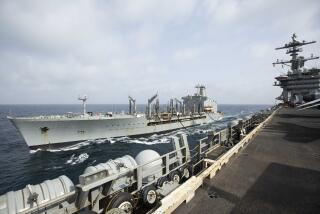Iraq Declares Stark Was Inside War Zone; Pentagon Denies It : U.S. Says Other Craft Placed Ship Miles From Area
WASHINGTON — The Iraqi government, during a joint investigation of the attack on the U.S. frigate Stark, told U.S. officials the ship was accidentally attacked because it was inside a war zone in the Persian Gulf, a contention disputed by the United States, the Pentagon said today.
U.S. officials say they have numerous “positive fixes” and radar tracking data on the Stark’s location that show it was nearly 20 miles outside the so-called Iranian exclusion zone at the time of the May 17 attack.
The Iraqi military has maintained the claim, however, and it emerged as the “essential difference” between the two countries in sorting through the events leading up to the attack, the Pentagon said in an account of the investigation.
“The essential difference in the U.S. and Iraqi versions of what occurred in the attack on USS Stark concerns the exact locations of both the Iraqi Mirage F-1 and USS Stark throughout the attack,” the Pentagon report said.
“The (Iraqi) pilot felt assured that the target was within the Iranian-declared exclusion zone, and that it was therefore Iranian or supporting the Iranian war effort.”
But data recorded by a patrolling U.S. AWACS (airborne warning and command systems) radar plane, the guided missile destroyer Coontz and the Stark put the ship miles outside of the zone, the Pentagon account said.
“We are convinced Stark was 10 to 15 nautical miles (11.5 to 17.25 statute miles) outside the Iran-declared exclusion zone. Iraq is convinced Stark was 20 to 25 miles (23 to 28.75 statute miles) farther east, inside the zone.”
First Missile a Dud
The Pentagon chronology also said the Iraqi plane had been modified to carry two Exocet missiles; that the first missile fired by the plane hit the ship but did not explode, and that it was the second missile that arrived about 25 seconds later that did explode.
Matching radar and tracking data from the U.S. military with the Iraqi account, the report also said the Iraqi pilot claims to have fired his first missile before the Stark radioed its first warning to the approaching plane, but that he did not hear any of two radioed warnings in any event.
“The Iraqis stated that this particular pilot’s experience was good,” the report said. “Like other Iraqi pilots, he understands English, especially aviation English.”
The F-1 pilot thought he had fired at an Iranian ship and did not know until the following day, “through the news media,” that what he had attacked was the Stark, the Iraqis told Rear Adm. David Rogers, who headed a team of U.S. military and diplomatic officials that recently returned from joint consultations with the Iraqis in Baghdad.
Rogers and his investigators were not able to talk to the Iraqi pilot while they were in Iraq.
Both the United States and Iraq have characterized the attack as an accident and a case of mistaken identity. Iraq has issued a formal apology and pledged to provide compensation for the attack, which left 37 sailors dead.
More to Read
Sign up for Essential California
The most important California stories and recommendations in your inbox every morning.
You may occasionally receive promotional content from the Los Angeles Times.









